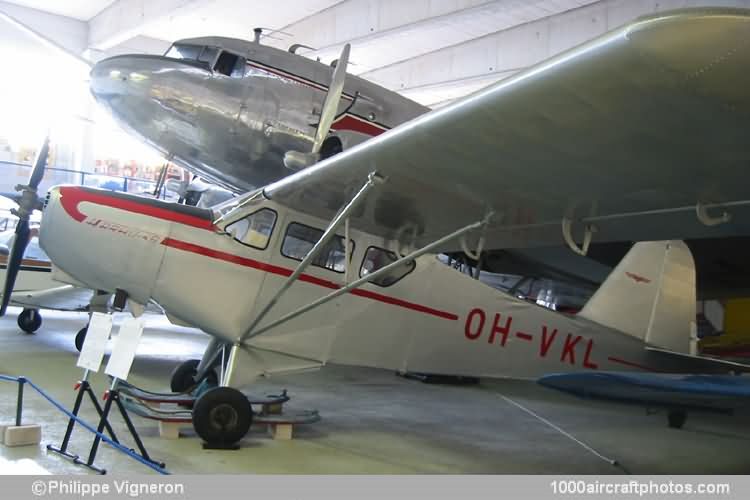They formed a company called Veljekset Karhumäki Oy (Karhumäki Brothers Ltd.) and their operations comprised aircraft construction, repairs and maintenance, pilot training, taxi flying, public displays, and aerial photography and air photography. In addition to its own aircraft, the company used de Havilland Moths, which it built under license, and Cessna monoplanes during the 1930s.
The Finnish Air Force soon required their assistance, and as there was no airfield at Keljo, which made it necessary for their aircraft to take off from either water or ice, the factory was moved in 1939 to Kuorevesi, where an airfield was available (presently known as Halli Airport), as well as a lake for seaplane or skiplane operations. This factory was further expanded during World War II, when the Valtion Lentokonetehdas (State Aircraft Factory) set up their dispersed location 2VL factory there (in 1951 Valtion became Valmet, into which the Karhumäki factory merged in 1963).
The number of workmen employed has varied between 120 and 250, and the factory was able to build all aircraft parts except for engines and instruments. After WW II an aircraft-radio service department was added to the plant. During its lifetime the company operated at least 16 aircraft, and by 1950 about 400 aircraft had either been built, repaired or overhauled, the majority belonging to the Finnish AF. About 60,000 passengers have been carried and over 100 students had received pilot training.
During 1976-1947 Karhumäki developed the four-seat cabin monoplane Karhu 48 in collaboration with Valtion. The development team included Uuno Karhumäki, Matti Hahka and August Puukko from Karhumäki and Torolf Eklund, Johannes Joensuu, Oiva Lounivuo, Toivo Mäntysalo, Karl Konrad Wessman, Paavo Paitula, Olavi Raitio and Aaretti Nieminen from Valtion, Nieminen being appointed team leader.
Two prototypes were completed, the first, registered OH-VKK and named Nalle, was flown for the first time by Uuno Karhumäki (the youngest of the Karhumäki brothers) on July 20, 1948. The second, which flew later that year, was registered OH-VKL and named Tavi. Planned production did not materialize by the import of cheap military surplus aircraft, and subsequently both aircraft were used by Karhumäki.
OH-VKL eventually had its wing modified and was redesignated Karhu 48B, it was reregistered OH-KUA in 1961. After being deregistered in 1973, the aircraft eventually ended up at the Suomen Ilmailumuseo (Finnish Aviation Museum), where it is displayed in its initial markings."
Wings: High-wing rigidly braced monoplane. Wing braced by steel-tube V-struts. Two-spar wooden structure covered with fabric. Flaps and ailerons with welded steel-tube frames and fabric covering.
Fuselage: Welded steel-tube structure covered with fabric.
Tail unit: Braced monoplane type. Welded steel-tube framework covered with fabric.
Landing gear: Tail wheel type with interchangeable wheels and skis. Faired side vees, incorporating springing, and two half axles hinged at center line of underside of fuselage. Steerable tail wheel. The landing gear could be replaced by twin all-metal single-step floats of Karhumäki design and construction, with a rudder on port float.
Power plant: One 190 hp Lycoming O-435A six-cylinder horizontally-opposed air-cooled engine driving an Acromatic 220 variable-pitch airscrew.
Accommodation: Enclosed cabin seating four, two single seats in front with removable dual controls and a full-width seat aft. Entrance door on each side. Two baggage compartments. Cabin heating and ventilation. Radio fitted as standard.
|
|
Landplane |
Seaplane |
